

Wal basses are hand-crafted bass guitars produced since the early 1970’s by Electric Wood in High Wycombe, Buckinghamshire in the UK. Since then they have come to be regarded as the standard by which others are judged on concert stages and recording studios across the world.
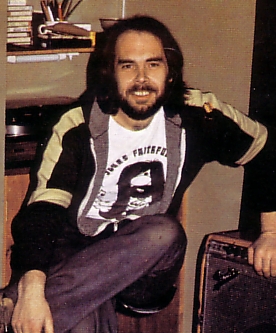
 The story
began in 1973 when an amateur luthier called Pete (“The Fish”) Stevens began
collaborating with Ian Waller, an electronics expert, to build what they
considered to be the ultimate in bass guitars. Pete had been working in the
exotic fish importing business – hence his unusual nickname – but a downturn
prompted by the early ‘70s oil crises and the temporary closure of the Suez
Canal led to him working at the Farmyard rehearsal studio which was run by
drummer Trevor Morais. While working at the studio he met and became friends
with Ian Waller.
The story
began in 1973 when an amateur luthier called Pete (“The Fish”) Stevens began
collaborating with Ian Waller, an electronics expert, to build what they
considered to be the ultimate in bass guitars. Pete had been working in the
exotic fish importing business – hence his unusual nickname – but a downturn
prompted by the early ‘70s oil crises and the temporary closure of the Suez
Canal led to him working at the Farmyard rehearsal studio which was run by
drummer Trevor Morais. While working at the studio he met and became friends
with Ian Waller.
Initially working on a custom only basis they began building basses for some of the best known players on the London session scene of the time under the name “Electric Wood”. Trevor Morais’ contacts proved to be invaluable in building up contacts – at the time he was setting up the jazz rock band “Quantum Jump” (which also featured later Rush producer, Rupert Hine). Through these contacts the first ever Wal bass was commissioned by John G Perry, a session pro, bassist for Quantum Jump, Caravan and later Curved Air and the in-house bass player for Redan Recorders and Triumvirate Productions.
The first ever Wals
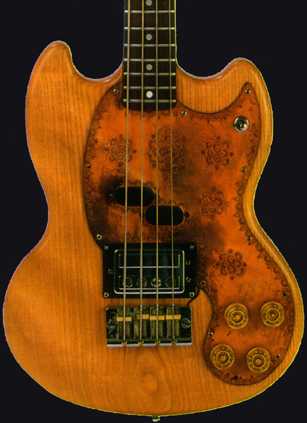
 The bass,
dubbed W1111, was a short scale (30 ¼”), ash bodied bass loosely based on a
Gibson EB3 bass, although with a more smoothly rounded shape reminiscent of a
Fender Musicmaster or Mustang. The hardware was culled from a variety of
sources – bridge, switches and knobs from a Gibson, rewound Guild and Fender
Mustang pickups and Schaller machine heads. However, the most visually
striking aspect of the bass was the scratchplate made of hand tooled leather on
a metal screening plate. Clearly a prototype, many of the design elements which
would go to make
The bass,
dubbed W1111, was a short scale (30 ¼”), ash bodied bass loosely based on a
Gibson EB3 bass, although with a more smoothly rounded shape reminiscent of a
Fender Musicmaster or Mustang. The hardware was culled from a variety of
sources – bridge, switches and knobs from a Gibson, rewound Guild and Fender
Mustang pickups and Schaller machine heads. However, the most visually
striking aspect of the bass was the scratchplate made of hand tooled leather on
a metal screening plate. Clearly a prototype, many of the design elements which
would go to make
 up the early “Pro” series and Mark I custom Wal basses were
already in evidence. Although passive and suffering some matching problems
between the two, very different, pickups. Even so, the bass has a very pleasing
sound and has something of the sound of a Wal about it – presumably partly due
to Ian’s hand rewinding of the pickups. This bass became one of
John G Perry’s main
basses
for the rest of the decade and both its look and sound drew much interest
from John’s bass playing colleagues. It can be heard on albums such as
“Visionary”, “Perilous Journey”,
up the early “Pro” series and Mark I custom Wal basses were
already in evidence. Although passive and suffering some matching problems
between the two, very different, pickups. Even so, the bass has a very pleasing
sound and has something of the sound of a Wal about it – presumably partly due
to Ian’s hand rewinding of the pickups. This bass became one of
John G Perry’s main
basses
for the rest of the decade and both its look and sound drew much interest
from John’s bass playing colleagues. It can be heard on albums such as
“Visionary”, “Perilous Journey”,
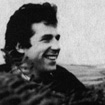 “Fear of the Dark” and “Peacock Party” by the
Gordon Giltrap Band (available from
www.voiceprint.co.uk
).
“Fear of the Dark” and “Peacock Party” by the
Gordon Giltrap Band (available from
www.voiceprint.co.uk
).
As an aside, the W111 was stolen from John G Perry’s car in the mid 1980’s. However, in the early 1990’s Pete Stevens was able to reacquire it after a dealer recognized its significance. Now it resides in its rightful home in the rack of basses at the Wal workshop.
 John G Perry playing a JG Series bass at a Gordon Giltrap session in 1978
John G Perry playing a JG Series bass at a Gordon Giltrap session in 1978
John
G Perry pictured in early Wal Pro Series promotional literature

Three headed Monster

 However,
Electric Wood’s next commission was, if anything, perhaps their strangest.
Roger Newell had recently been recruited as
bass player in Rick Wakeman’s band the “English Rock Ensemble”. He soon came to
realize that to compete with playing for Journeys to the Centre of the Earth and
King Arthur on Ice he would need a bass that was a little bit different.
Ever the showman, Rick agreed. He knew that there were other progressive
rock bans with twin-neck basses so his band would have to have a TRIPLE
neck bass. In
1974 he commissioned Ian and Pete to build Roger a triple necked bass guitar.
This bass would feature a conventional four-string fretted neck, a four string
fretless neck (both tuned EADG ) and a short scale six string neck guitar
neck (this has since been reset to feature
three courses of double strings tuned ADG in octave pairs). Again the hardware
came from a variety of sources, Schaller guitar and bass tuning pegs, custom
made Fender style bridges and pickups culled from Fender Mustangs and a Fender
Telecaster. Like W1111 it features the leather scratch plate which would be a Wal
signature
However,
Electric Wood’s next commission was, if anything, perhaps their strangest.
Roger Newell had recently been recruited as
bass player in Rick Wakeman’s band the “English Rock Ensemble”. He soon came to
realize that to compete with playing for Journeys to the Centre of the Earth and
King Arthur on Ice he would need a bass that was a little bit different.
Ever the showman, Rick agreed. He knew that there were other progressive
rock bans with twin-neck basses so his band would have to have a TRIPLE
neck bass. In
1974 he commissioned Ian and Pete to build Roger a triple necked bass guitar.
This bass would feature a conventional four-string fretted neck, a four string
fretless neck (both tuned EADG ) and a short scale six string neck guitar
neck (this has since been reset to feature
three courses of double strings tuned ADG in octave pairs). Again the hardware
came from a variety of sources, Schaller guitar and bass tuning pegs, custom
made Fender style bridges and pickups culled from Fender Mustangs and a Fender
Telecaster. Like W1111 it features the leather scratch plate which would be a Wal
signature 
 until the first production, “Pro” series, basses were launched in
1978. This bass was later given by Wakeman to Chris Squire of Yes
(to Newell's understandable annoyance!) and it is currently on loan to the Hard Rock Café in New York. Strangely, although Squire still
regularly plays a Wal triple neck on stage for extended versions of the song
“Awaken” that bass was not made by Wal but is, rather, a replica built for him
by a Japanese luthier (all photographs here are sadly of the replica).
until the first production, “Pro” series, basses were launched in
1978. This bass was later given by Wakeman to Chris Squire of Yes
(to Newell's understandable annoyance!) and it is currently on loan to the Hard Rock Café in New York. Strangely, although Squire still
regularly plays a Wal triple neck on stage for extended versions of the song
“Awaken” that bass was not made by Wal but is, rather, a replica built for him
by a Japanese luthier (all photographs here are sadly of the replica).
Slap Leather

 More
commissions followed (38 custom basses in all). The next customers were John
Gustafson (of the Merseybeats, the Ian Gillan Band,
Episode Six, the Big Three, Quatermass
and Roxy Music) whose
name was the basis of this series of basses - the "JG Custom" series. The
basses were made on a semi-custom basis and were characterised by their
distinctive leather
More
commissions followed (38 custom basses in all). The next customers were John
Gustafson (of the Merseybeats, the Ian Gillan Band,
Episode Six, the Big Three, Quatermass
and Roxy Music) whose
name was the basis of this series of basses - the "JG Custom" series. The
basses were made on a semi-custom basis and were characterised by their
distinctive leather
 tooled scratchplates. Other early users
who all contributed to the technical development of the bass were players of the likes of
John Entwistle, Pete Zorn, Rupert Hine and Percy Jones
of the jazz-rock band “Brand X” (John Entwistle's
photograph also
featured in some early Electric Wood
adverts). It was over this period that Ian strove to perfect the electronics
which would form the foundation of the signature Wal
sound.
tooled scratchplates. Other early users
who all contributed to the technical development of the bass were players of the likes of
John Entwistle, Pete Zorn, Rupert Hine and Percy Jones
of the jazz-rock band “Brand X” (John Entwistle's
photograph also
featured in some early Electric Wood
adverts). It was over this period that Ian strove to perfect the electronics
which would form the foundation of the signature Wal
sound.


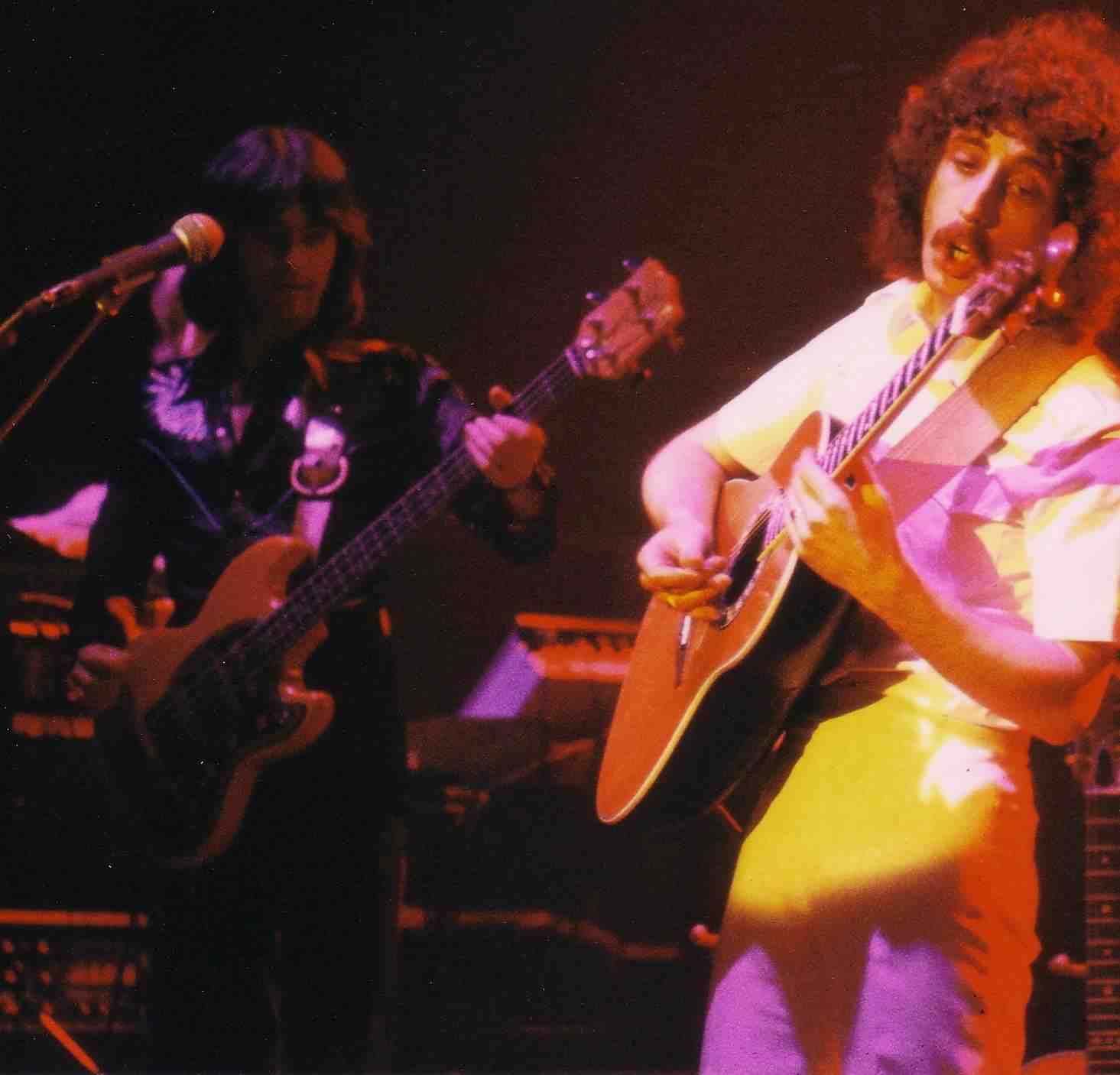
John Gustafson using his JG Customs live on stage with the Gordon Giltrap Band
Production Line Basses
 As the
pair’s design concepts were honed through the feedback received from their
celebrity customers Ian and Pete decided to synthesize these into a production
(or "Pro") series bass. In 1978 the Pro series basses were launched. Comprising
four distinct models these were a development of the Custom-built basses like
John Gustafson’s. Assisting at this stage was another member of the
electronics development team, Ivan Bozicevic.
As the
pair’s design concepts were honed through the feedback received from their
celebrity customers Ian and Pete decided to synthesize these into a production
(or "Pro") series bass. In 1978 the Pro series basses were launched. Comprising
four distinct models these were a development of the Custom-built basses like
John Gustafson’s. Assisting at this stage was another member of the
electronics development team, Ivan Bozicevic.

 The bodies
were made of solid ash and the distinctive leather scratchplate was replaced by
a plastic one (still mounted on a metal screening plate). The early necks were
a 10 piece laminate construction (hornbeam in the centre, and then two strips of
mukalungu and maple alternating towards the edge of the neck. Later Pro series
necks features only 8 laminates (dispensing with the mukalungu laminates in the
headstock. Pro series necks also included three reinforcing carbon-fibre
strips, one under the fretboard and two in the main body of the neck.
The bodies
were made of solid ash and the distinctive leather scratchplate was replaced by
a plastic one (still mounted on a metal screening plate). The early necks were
a 10 piece laminate construction (hornbeam in the centre, and then two strips of
mukalungu and maple alternating towards the edge of the neck. Later Pro series
necks features only 8 laminates (dispensing with the mukalungu laminates in the
headstock. Pro series necks also included three reinforcing carbon-fibre
strips, one under the fretboard and two in the main body of the neck.

 The
four Pro series models were as follows: the Pro I (passive, one centrally
placed pickup), Pro II (passive, two pickups), Pro IE (active, one centrally
placed pickup) and Pro IIE (active, two pickups). The active basses included
sophisticated tone altering facilities which had been included on the JG
Custom
models (on the JG
Customs they had been mounted on the pickup mounting rings, on
the Pro E’s they resided on the scratchplate underneath each pickup. In
addition the Pro basses saw the introduction of a “Pick-Attack” switch. This
switch activated an active boost function which added a narrow band of high
frequencies to the overall tone – adding a plectrum style attack to notes, even
when played fingerstyle. A balanced XLR output could be specified
as a custom option.
The
four Pro series models were as follows: the Pro I (passive, one centrally
placed pickup), Pro II (passive, two pickups), Pro IE (active, one centrally
placed pickup) and Pro IIE (active, two pickups). The active basses included
sophisticated tone altering facilities which had been included on the JG
Custom
models (on the JG
Customs they had been mounted on the pickup mounting rings, on
the Pro E’s they resided on the scratchplate underneath each pickup. In
addition the Pro basses saw the introduction of a “Pick-Attack” switch. This
switch activated an active boost function which added a narrow band of high
frequencies to the overall tone – adding a plectrum style attack to notes, even
when played fingerstyle. A balanced XLR output could be specified
as a custom option.
The launch
of the Pro Series coincided with Electric Wood beginning an association with
Barratt’s Music Shop in Manchester and a move of workshop to High Wycombe in
Buckinghamshire. Prior to this the base had been an old woodworking shop off
London’s Marylebone Road, Ian’s front room and a small premises in
 Sedley Place,
London. During this period Pete had still been working at Farmyard Studios and
driving the legendary Rolling Stones Mobile recording studio; Wal was still
producing various bits of electronic gadgetry for the film industry and others.
The distribution deal with Barratt’s meant that they could finally concentrate
on their bass building. The Pro Series basses were launched Barratt’s stand at
the 1978 Frankfurt Music Messe. It was a close run thing though as Pete and Wal
added finishing touches to their precious cargo while in transit.
Sedley Place,
London. During this period Pete had still been working at Farmyard Studios and
driving the legendary Rolling Stones Mobile recording studio; Wal was still
producing various bits of electronic gadgetry for the film industry and others.
The distribution deal with Barratt’s meant that they could finally concentrate
on their bass building. The Pro Series basses were launched Barratt’s stand at
the 1978 Frankfurt Music Messe. It was a close run thing though as Pete and Wal
added finishing touches to their precious cargo while in transit.
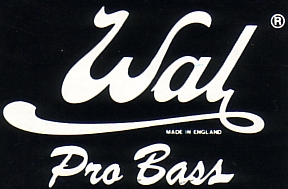 Despite
being classed as “Production” series basses, the Wal production line was never
envisaged as rivaling the output of the US and Japanese factories! In the early
days Pete and Wal would struggle to complete five or six basses a week. This
was due to the very high quality control standards which the pair set themselves
and the very high number of components which were made in-house or specially
commissioned/manufactured. Only the machine-heads were stock, off the shelf
items. This remains a Wal ethos to this day. In all, between 1978 and 1982,
only around 700 Pro Series basses were made
(calculated on the basis of the serial numbers).
Despite
being classed as “Production” series basses, the Wal production line was never
envisaged as rivaling the output of the US and Japanese factories! In the early
days Pete and Wal would struggle to complete five or six basses a week. This
was due to the very high quality control standards which the pair set themselves
and the very high number of components which were made in-house or specially
commissioned/manufactured. Only the machine-heads were stock, off the shelf
items. This remains a Wal ethos to this day. In all, between 1978 and 1982,
only around 700 Pro Series basses were made
(calculated on the basis of the serial numbers).
Custom Series Basses

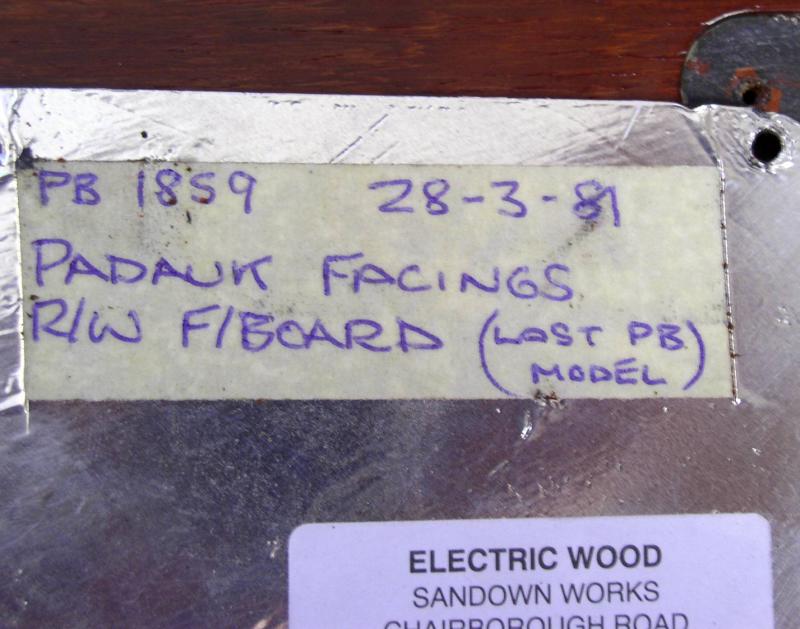 Fine
instruments though the Pro Series Wals were Ian and Pete were not content to
rest on their laurels – still eager to fulfill their vision of the perfect bass
guitar. This took a step forward in 1981 as the Pro
series basses were phased out and replaced by the “Custom Series” – the staple
Wal range (with some tweaks and additions along the way) to this day.
In this transition phase a number of basses were built with "Pro bass"
serial
numbers (starting with PB) which were to all intents and purposes Wal "Custom
Series" basses. These Wal equivalents of the Fender "Nocaster" still cause
confusion over the nature of the Pro series to this day! The "last ever
Pro" bass (PB1859), completed on March 28th 1981 was just such a
transitional bass! Subsequent basses started with a W serial number -
presumably W1860.
Fine
instruments though the Pro Series Wals were Ian and Pete were not content to
rest on their laurels – still eager to fulfill their vision of the perfect bass
guitar. This took a step forward in 1981 as the Pro
series basses were phased out and replaced by the “Custom Series” – the staple
Wal range (with some tweaks and additions along the way) to this day.
In this transition phase a number of basses were built with "Pro bass"
serial
numbers (starting with PB) which were to all intents and purposes Wal "Custom
Series" basses. These Wal equivalents of the Fender "Nocaster" still cause
confusion over the nature of the Pro series to this day! The "last ever
Pro" bass (PB1859), completed on March 28th 1981 was just such a
transitional bass! Subsequent basses started with a W serial number -
presumably W1860.
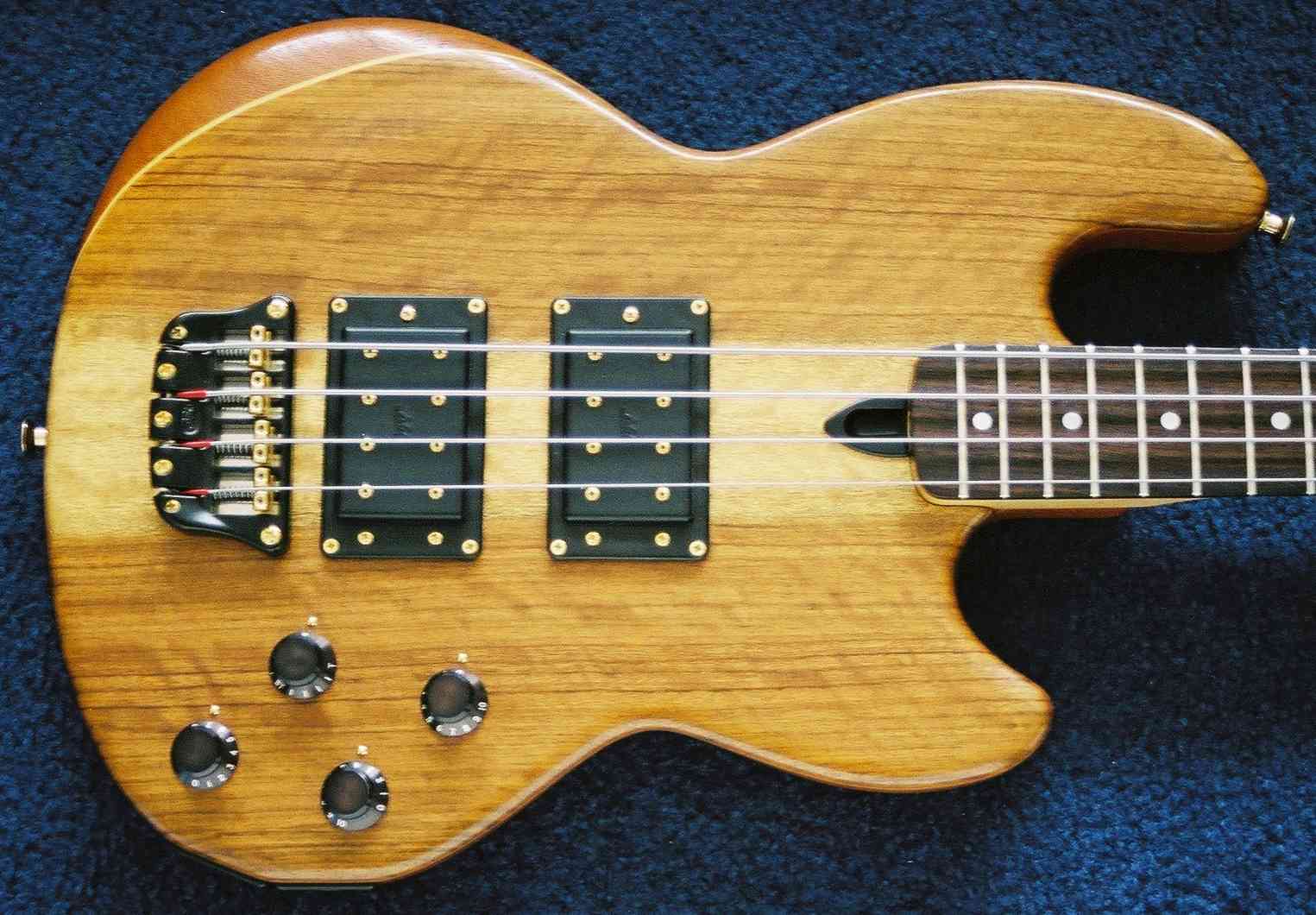
 The
"Custom Series" dispensed with the Pro series' scratchplate - surface mounting the pickups and controls -
and replaced a solid ash body with a mahogany body core faced with a selection
of exotic woods. As much as you can ever have a "standard" range with a
builder which takes such a custom building approach as Wal, the standard woods
used for the facings are paduak, wenge, American walnut or hydua/schedua.
Pete always reckons that for fretless basses walnut is the premium wood to use.
The
"Custom Series" dispensed with the Pro series' scratchplate - surface mounting the pickups and controls -
and replaced a solid ash body with a mahogany body core faced with a selection
of exotic woods. As much as you can ever have a "standard" range with a
builder which takes such a custom building approach as Wal, the standard woods
used for the facings are paduak, wenge, American walnut or hydua/schedua.
Pete always reckons that for fretless basses walnut is the premium wood to use.
The new neck were similar to the Pro series - 34"/864mm scale length and 21
frets but with a slimmer headstock allowing straight string bull over the nut.

 Biggest
change, however, was probably to the electronics. The standard package was
now twin pickups with a powerful active circuit offering volume, pickup pan and
separate tone controls for each pickup. The volume included a push/pull
knob which also activates the "pick-attack" feature. This adds a narrow
band of high frequencies to the overall tone setting to provide a more dynamic.
percussive attack - ideal for helping the bass cut through a muddy live mix.
The tones are low-pass shelving controls governing each pickup. They also
each have a push/pull switch which engages an active boost (quasi-parametric)
giving a more distinctively "active" tone. A balanced XLR output comes as
standard on all "Custom series" basses. A choice between chrome
and gold
hardware was now also available.
Biggest
change, however, was probably to the electronics. The standard package was
now twin pickups with a powerful active circuit offering volume, pickup pan and
separate tone controls for each pickup. The volume included a push/pull
knob which also activates the "pick-attack" feature. This adds a narrow
band of high frequencies to the overall tone setting to provide a more dynamic.
percussive attack - ideal for helping the bass cut through a muddy live mix.
The tones are low-pass shelving controls governing each pickup. They also
each have a push/pull switch which engages an active boost (quasi-parametric)
giving a more distinctively "active" tone. A balanced XLR output comes as
standard on all "Custom series" basses. A choice between chrome
and gold
hardware was now also available.
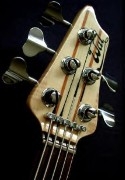
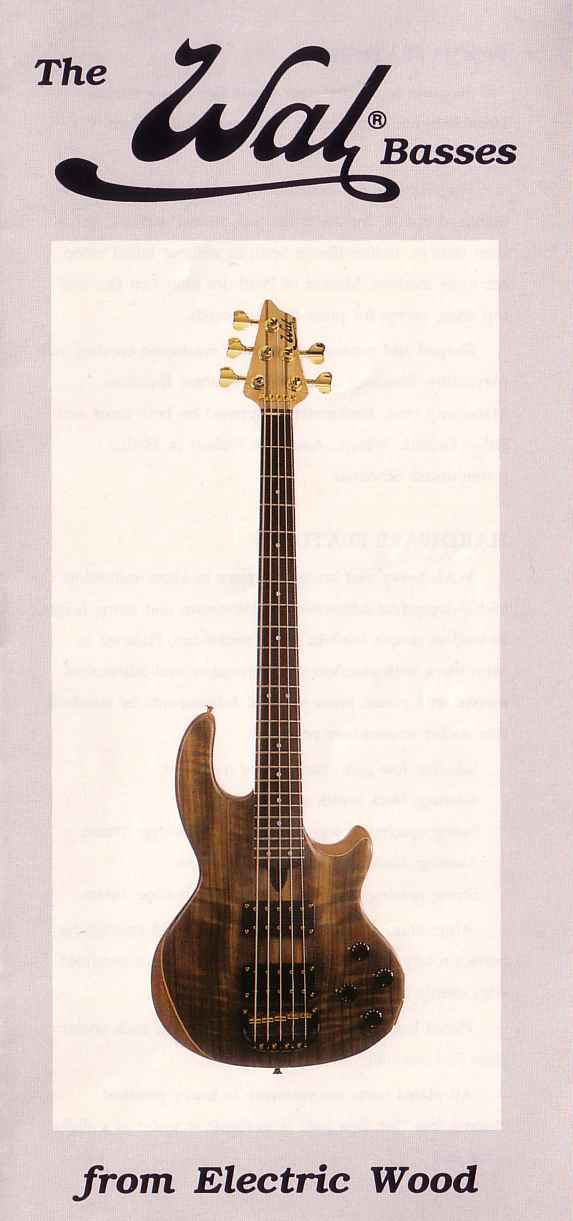 In
March 1986 Wal introduced a 5-string bass with a 24
fret neck and a revised body shape (Mark II) which was also applied as an option
to the 4-string basses. This Mark II body shape included more
asymmetric body horns with an extended upper horn. This significantly
increased the mass of the body. In addition the included 24 frets and a
revised headstock shape).
In
March 1986 Wal introduced a 5-string bass with a 24
fret neck and a revised body shape (Mark II) which was also applied as an option
to the 4-string basses. This Mark II body shape included more
asymmetric body horns with an extended upper horn. This significantly
increased the mass of the body. In addition the included 24 frets and a
revised headstock shape).
Tragically, Ian Waller died suddenly of a heart attack in 1988 and his passing was marked across the music industry. Despite this irreplaceable loss, Pete Stevens was determined to carry on Ian's legacy and continue building world beating basses.
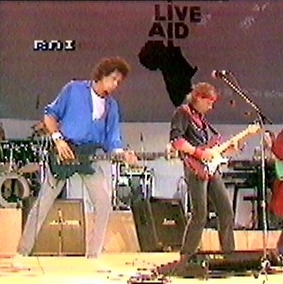 Through
the course of the 1980s, the Wal Custom became a staple of studios and stages
throughout finding favour with artists as diverse as Paul
McCartney, Dire Straits, Spandau Ballet, Mick Karn of Japan and Geddy Lee of Rush (at least two Wals even
appeared on stage at "Live
Aid" in Wembley Stadium in the hands of Martin Kemp of Spandau Ballet and
John Illsley of Dire Straits). The bass line on the original "Band Aid" single,
"Do they know it's Christmas" (one of the biggest and most influential singles
of all time) was powered by Wal. By the end of that decade it was being
considered by many as the "industry standard" for studio basses.
Through
the course of the 1980s, the Wal Custom became a staple of studios and stages
throughout finding favour with artists as diverse as Paul
McCartney, Dire Straits, Spandau Ballet, Mick Karn of Japan and Geddy Lee of Rush (at least two Wals even
appeared on stage at "Live
Aid" in Wembley Stadium in the hands of Martin Kemp of Spandau Ballet and
John Illsley of Dire Straits). The bass line on the original "Band Aid" single,
"Do they know it's Christmas" (one of the biggest and most influential singles
of all time) was powered by Wal. By the end of that decade it was being
considered by many as the "industry standard" for studio basses.
The original "Custom Series" design (Mark I) of four control electronics and a mahogany/exotic wood laminate body has since formed the template for all further developments and versions of the Wal Bass.
The Wal MIDI Bass
An interesting aside in the history of the Wal bass it the MB4 midi-bass. In the mid 1980’s an Australian bass player called Steve Chick, frustrated with what was already on the market, decided to develop a working bass synth system which combined accurate note tracking with immediate sounding notes. He hit on the perfect solution to solve the “midi delay” dilemma – the almost imperceptible (but still noticeable and distracting) delay caused by the time taken for the midi hex pick-up to sense the note being played. His system did not rely fully on the hex pick-up for pitch information. Instead, sensors were built into the frets (each of which was split into four separate pieces) to determine the basic pitch of the note.
Around 1990 the Wal MB4 Midi bass was launched to much acclaim - mostly because it actually worked without the delay which had plagued other midi-bass systems. Unfortunately, after only a few years, the rights to Chick's midi-bass was bought up by US guitar giant Peavey for the development of their Midibase and then Cyber-bass. This brought an end to the production of the Wal MB4 midi-bass. These remain sought after items on the second hand market.
The New Pros


 In
1990, just to throw more confusion on what constitutes a "Wal Pro bass",
Electric Wood produced a new, single pick-up, low cost bass also referred to as
Pro basses. These were manufactured in response to a major UK music
retailer who wanted to be able to offer a Wal bass at a lower price.
In
1990, just to throw more confusion on what constitutes a "Wal Pro bass",
Electric Wood produced a new, single pick-up, low cost bass also referred to as
Pro basses. These were manufactured in response to a major UK music
retailer who wanted to be able to offer a Wal bass at a lower price.
These later period "Pro basses" were equipped with passive tone circuits which were mounted on a small plastic scratchplate and included a tone shaping switch similar to those on the original passive Pro I basses - basically a series/parallel switch. The headstocks on these later "Pro basses" were also a slightly different shape from the "Custom series" basses.
And then there were mark three


 In 1995 the Wal underwent a further design development with
the introduction of a 6-string bass and a new body shape (the "Mark III" body
shape). The increased body mass necessitated by the wider neck required
slimming down of the chunky Mk II body shape. The following year the Mark
III body shape was extended as an option across the entire Wal range - 4, 5 and
6 strings, all including the newer asymmetric headstock shape. This was
partly inspired by a suggestion made by Roger Newell in a review of the Mk III
body shape Wal 5 string in Bassist Magazine. Wals are now offered in 6
different formats... the Mk I, 21-fret 4-string; Mk II, 24-fret 4-string; Mk II,
24-fret 5-string; Mk III, 24-fret 4-string; Mk III, 24-fret 5-string; and Mk
III, 24-fret 6-string.
In 1995 the Wal underwent a further design development with
the introduction of a 6-string bass and a new body shape (the "Mark III" body
shape). The increased body mass necessitated by the wider neck required
slimming down of the chunky Mk II body shape. The following year the Mark
III body shape was extended as an option across the entire Wal range - 4, 5 and
6 strings, all including the newer asymmetric headstock shape. This was
partly inspired by a suggestion made by Roger Newell in a review of the Mk III
body shape Wal 5 string in Bassist Magazine. Wals are now offered in 6
different formats... the Mk I, 21-fret 4-string; Mk II, 24-fret 4-string; Mk II,
24-fret 5-string; Mk III, 24-fret 4-string; Mk III, 24-fret 5-string; and Mk
III, 24-fret 6-string.
Millennium bugs... Wal to the Present day
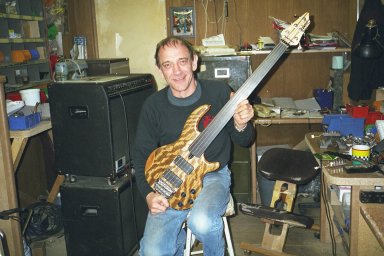 For the last few years,
despite the inconvenience of several workshop moves, Pete has
continued building Wal basses as a small, often one-man, operation. He
continues to offer
these fine instruments in the three body styles, faced with a wide range of beautiful
exotic woods and in 4, 5 and 6 string
incarnations to the discerning bassists of Britain and the world. Long may
that continue and the vision and legacy of Ian Waller - to build the best bass
guitars in the world - remain alive.
For the last few years,
despite the inconvenience of several workshop moves, Pete has
continued building Wal basses as a small, often one-man, operation. He
continues to offer
these fine instruments in the three body styles, faced with a wide range of beautiful
exotic woods and in 4, 5 and 6 string
incarnations to the discerning bassists of Britain and the world. Long may
that continue and the vision and legacy of Ian Waller - to build the best bass
guitars in the world - remain alive.
Trevor Raggatt, August 2004
Back to Main page Back to Basses page
Go to Guitars page Go to Links page
Credits
This history of Wal Basses owes a debt to many people and many sources. Notable among the written sources have been the many excellent UK guitar and bass magazines - Guitarist Magazine, Bassist Magazine (particularly their two part "Wal Bass Special" published in October and November 1996), The Guitar Magazine, Tony Bacon's "The Ultimate Guitar Book" and Barry Moorhouse's "The Bass Book". Many of the images on this site have been photographed by myself or taken from the various pieces of Wal memorabilia which I have amassed over the years of following the progress of the Wal bass. Particular thanks must go to Gordon Giltrap who kindly allowed me access to photographs of his band in action in 1978 with John Gustafson playing his "JG Series" Wal. Finally, thanks go to all those who contribute to the ongoing debates and banter on the Wal bass fora on Yahoo and at the Dudepit.
Text: Trevor Raggatt © 2004